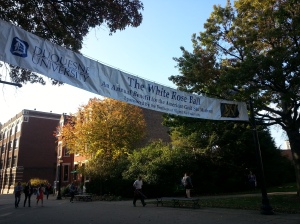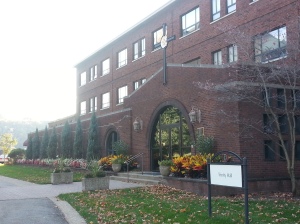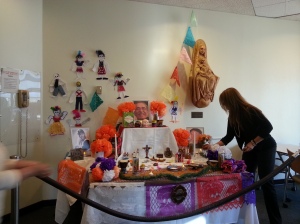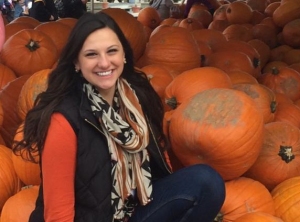
Nina Linhart, 19, of Plum, poses among the pumpkins at Trax Farms. Photo taken by Katie Lipko. Oct. 25, 2014.
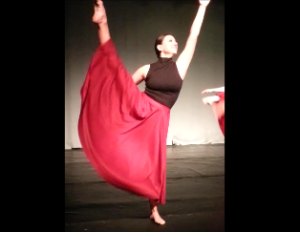
Nina Linhart, 19, of Plum, dances to “Spiegel im Spiegel” during the Duquesne University Dance Theatre’s Fall 2014 Showcase, held Friday, December 12, 2014, at the Peter Mills Theater, Rockwell Hall. Photo taken by Katie Lipko.
“I would if it was Radio City. And if it just happened by chance.”
Those are the words said by 19-year-old Nina Linhart born and raised in Plum, Pennsylvania when asked if she would ever want dance as her career. Dance, an activity that has been a part of her life since the age of 2. An activity that has given Linhart numerous opportunities. One of which being the chance to become a Rockette for the famous dance troupe located in non-other than Radio City Music Hall, New York City.
Currently an early childhood education major at Duquesne University, Pittsburgh, Linhart began dance early in life with the Abby Lee Dance Company (ALDC) , made famous from the television show “Dance Moms.” It was here, under the tutelage of Abby Lee herself that Nina Linhart discovered how much dance meant to her. The ALDC is primarily a competition based company with only one night a week devoted to recreation dancing, that Linhart now teaches. Abby Lee realized Linhart’s potential and asked her to audition for the competition team. At age 6, Linhart began competing. It was time consuming, practicing “all night every night,” said Linhart.
It was this hard work and dedication, however that allowed Linhart to win the 2011 title of Miss Dance of Pennsylvania, her most important competitive accomplishment to this day.
Then came the Rockettes. “I honestly didn’t even know what they were when I was little,” said Linhart. Auditioning for this dance company only became an option when the dancer had a growth spurt, reaching 5 feet 10 inches. Linhart’s teacher, Abby Lee, suggested that she try out since she had the number one requirement the Rockettes look for, long legs. Linhart did not see any harm in trying so she traveled to New York City, auditioned for the Rockettes Summer Intensive Program the summer going into her junior year at Plum Senior High School and got accepted. This program is a weeklong session that trains dancers to be Rockettes so that when they do audition for the actual job they are better equipped.
In addition to the Summer Intensive, Linhart received help from a former Rockette and graduate from the Abby Lee Dance Company. “I had a private lesson with her and she taught me a combination and she was like, ‘they’re (the Rockettes) looking for precision so the more detail you can pick up in a combination the better,’” said Linhart. Details such as when your right hand goes over your left or vice versa. “You realize just how much work it is when you’re learning it,” said Linhart.
The Rockettes do auditions twice a summer, in the beginning of July and the end of August. However, there are more than just the New York City Rockettes. According to Linhart, there are two sets in New York, both at Radio City, a blue cast and a gold cast. One in Nashville at the Grand Ole Opry and then one that travels. When a dancer auditions, she auditions for all the Rockette groups and all auditions are held in a rehearsal hall at Radio City. Approximately 500 girls from all over the country as well as the world audition each time. The level of talent? Very hard, according to Linhart.
In the beginning of July 2013, the summer going into college, Linhart auditioned for the Rockettes for the first time. The entire audition process taking only two days, each day beginning at 10 a.m. and ending at 3 p.m. Both days include different rounds to complete, with each round requiring dancers to learn and execute new dance combinations. These combinations include jazz or tap numbers, as well as the famous Rockette kick line. Each combination is performed with two other dancers in front of the scrutinizing eyes of the choreographers, who then after seeing everyone dance, make cuts, eliminating dancers they do not believe will make it any other rounds. Linhart got cut after the first round.
Linhart did not give up and waited until the following July to audition again. She completed every round the first day and waited nervously in the rehearsal room until she heard the choreographers make the announcement, congratulating the remaining girls on receiving a callback and asking them to return for day two. Day two continued with new combinations and cuts and again, Linhart made it through to the very end. “If you make it the whole way through there is a possibility you’ll get a call for the job, there’s a possibility you won’t…I did not,” states Linhart on her second audition experience. “It all depends on how many spots need to be filled.”
Third audition is a charm, thought Linhart as she went back to audition again in August of the same summer. Like the second audition, she made it through the first day, however she got cut after a jazz combination on day two.
“I was really upset,” said Linhart, “because I had made it the whole way through the audition before , then I got cut and I was like what in the world did I do wrong. Like what did I do the time that I made it through that I didn’t do now? And it’s so frustrating because you don’t get feedback. So you’ll never know.”
Linhart states that the reason she was cut could be anything, including the color of her leotard that day. “If they (the choreographers) liked the way I looked last audition and they didn’t like it this time that could have been the reason.”
“It’s a precision troupe,” states Linhart. Detail is their main focus. She recalls that during the Summer Intensive she received a correction that her pinky finger was out of place. No detail goes unnoticed.
Linhart is not giving up, however, and fully plans to audition again this coming summer.
Nina Linhart is “dedicated” according to Caitlin Brown, 19 of Baldwin, an education major at Duquesne University as well as one of Linhart’s closest friends.
The two met, freshman year of college, living down the hall from each other. They had a mutual friend group and gradually became close. “We both love purple. That’s why we’re meant to be,” said Linhart. The two are such good friends that they have created their own language. “We have conversations in just song lyrics,” said Brown. “It makes people not involved in the song conversation really angry.”
If there is one aspect that really brought their relationship together it is food. “Our relationship is completely centered around food,” said Brown. It is a rare night when Linhart and Brown do not devour a large pizza in record time.
The girls became even closer when they both joined Alpha Gamma Delta, one of the sororities Duquesne University offers. They are not just friends but sisters as well.
Alpha Gamma Delta is just one of the seven organizations to which Linhart is a member. The six other include: Pittsburgh Association for Educating Young Children (PAEYC), Duquesne University Student Education Association (DUSEA), Phi Eta Sigma (a Nation Honor Society), Kappa Delta Epsilon (educational sorority), Red and Blue Crew and Duquesne University Dance Theater (DUDT).
Linhart became involved in Duquesne University Dance Theatre, previously Exhalations Dance Theatre, her freshman year at Duquesne. It was here that she met Lizzy Sorrentino, 21, from Lehigh Valley, Vice President of DUDT as well as fellow Alpha Gamma Delta.
“Nina’s always willing to listen if you need someone to talk to. She is honest and stays true to what she believes in,” said Sorrentino.
In regards to dance, Sorrentino says “Nina is really talented and works super hard at the things she takes on.” She has full faith that Linhart can accomplish anything she sets her mind to.
So for the question, does Nina Linhart have the ability to become a Rockette? Sorrentino believes she absolutely does. “She is the definition of someone who never gives up. She has the drive and the talent, it’s only a matter of time.”
And for the question, would Nina Linhart ever want dance to be her career? Linhart herself provides the answer. “I would if it was Radio City.”


